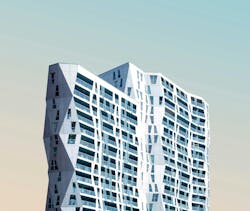First Mass Timber Panel Made from Structural Composite Lumber gets APA Certification
Freres Lumber Company says it has achieved Mass Plywood Panels (MPP) certification under the APA - The Engineered Wood Association's ANSI/APA PRG 320 standard. The product is the first Mass Timber Panel constructed entirely out of Structural Composite Lumber (SCL) worldwide, making it much more cost effective than CLT (cross-laminated timber) options, according to a Freres news release. Mass Timber Panels will allow rapid construction of multi-story structures with pre-fabricated structural wood panels, the release says.
The predictable char rate of mass timber panels allows buildings to be built taller with wood, allowing multi-story structures out of wood up to 18 stories anticipated in the next iteration of the International Building Code (IBC). Wood structures carry a smaller carbon footprint, provide greater sustainability, faster construction with less waste and are an economically favorable construction method compared to concrete and steel, Freres says.
The company says it is continuing to refine the design values of the product line, and will roll out additional MPP product configurations.
Resilience, Sustainability Emphasized in Plans for New 23,000-acre City in the Philippines
Resilience to natural disasters and sustainability are guiding planning for a new 23,350-acre city on the site of Clark Air Base in the Philippines. The Philippines, vulnerable to typhoons and earthquakes among other calamities, is one of the most disaster-prone places on Earth. Resiliency for the new city, expected to eventually house 1.2 million people, begins with its location where the lowest point will be more than 177 feet above sea level.
Only a third of the city’s land will be developed—the rest reserved for green spaces and agriculture, which will improve drainage and reduce flooding. Development will be sited away from earthquake fault lines. Developers will use concrete mixed with a local organic building material that will withstand shaking better than conventional concrete.
The city will be pedestrian-friendly with efficient mass transportation. One commentator remarked that “the right metaphor for Clark is iCloud—a backup for when Manila fails.” The development is expected to take 25 to 30 years to complete.
Cities Promote Deconstruction of Old Homes with Mixed Results
A few U.S. cities have created laws and regulations to encourage deconstruction of old—and sometimes abandoned—homes. Reclaiming old building materials rather than sending them to landfills holds great appeal, particularly in blighted areas of cities. Baltimore, Milwaukee, and Portland, Ore., have all initiated new ordinances aimed at promoting deconstruction as a way to create entry-level construction jobs and reduce demolition waste.
Portland’s ordinance requires developers to deconstruct homes or duplexes that are designated historic or were built in 1916 or earlier. The law allows contractors to apply for an exemption if a building is structurally unsafe or extensively damaged.
Portland’s effort has been uncontroversial and successful, with a quarter of the 318 demolition permits issued by the city in the first year the ordinance went into effect going for deconstruction. Initiatives in other cities, including Milwaukee, have struggled as contractors have difficulty turning a profit and finding workers.
Solar Power Costs Plunged by One-Third from 2013 to 2016
From 2013 to 2016, the cost of solar power dropped by one-third, according to a report from the U.S. Energy Information Administration. In 2013, the cost per kilowatt of solar power was about $3,700. By 2016, the cost had dropped to less than $2,500 per kilowatt, a price that doesn’t take into account federal, state, and local incentives.
“Solar does still have a long way to go before it reaches the same cost per kilowatt without subsidies as natural gas, so that doesn’t mean we’re headed to a purely solar country anytime soon,” according a recent Popular Mechanics article. “But it does mean that solar is here to stay, and will almost certainly be a big part of the foreseeable future.”
Document has Strategies for Multifamily Building Resilience
Ready to Respond: Strategies for Multifamily Building Resilience, a free document by Enterprise Green Communities, contains ideas to boost the resilience of multifamily buildings against the effects of extreme weather events. It draws on advice from over 50 resilience experts as well as the Federal Emergency Management Agency (FEMA) and the National Flood Insurance Program (NFIP).
In addition, the manual offers guidance on determining a property’s vulnerability to various hazards, finding which strategies are relevant to a particular building, and getting started with a resilience plan.
